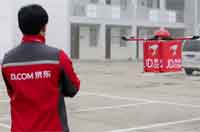| |
|
| |
|
 |
Supply
Chain by the Numbers |
| |
|
| |
- March 22, 2018 -
|
| |
|
| |
|
| |
|
| |
UPS Going All Electric in London after Breakthrough; Wil IMO Mandate Slow Steaming to Reduce CO2? US Truckload Rates Still Heading Higher; China's JD.com Spending Billions on Delivery Technology |
| |
|
| |
| |
| |
170 |
|
That is how many electric trucks UPS will have in operation in London over the next few years, versus 52 currently, the company said in a rather amazing announcement. That means its entire central London fleet would soon be made up of electric vehicles, and UPS said that this marked the "beginning of the end" of the reliance on internal combustion engines. That radical transformation is now possible, UPS said, due to the company's development of a "radical" electric vehicle-charging "smart grid" that has solved the problem of needing to recharge a large number of vehicles simultaneously, without having to pay for an expensive upgrade to the power supply grid, according to a report in London's Financial Times. UPS added that going electric will soon be a cheaper alternative to diesel. "We certainly believe this to be groundbreaking," said Peter Harris, director of sustainability at UPS Europe. The development will herald "a new generation of sustainable urban delivery services both here in London and in other major cities around the world". The company's new intelligent charging technology works by spreading the same amount of electricity between vehicles more efficiently. Although all can be plugged into charging points simultaneously, a computer will stagger which vehicles charge when.
|
|
|
| |
| |
|
|
|
That was the strong year-over-year increase in US truckload per mile rates before fuel surcharges and other accessorials in February, according to the just released Cass Linehaul Index for the month. That after gains of 6.3%, 6.2%, and 6.5% in November, December, and January, respectively, as transport costs continue to soar. After being negative for a record 13 months in a row (from March 2016 through March 2017), the Cass TL Linehaul Index has not only been positive now for 11 straight months, but pricing for trucking continues to increase. Meanwhile, while down a bit from January, the American Trucking Associations Freight Tonnage Index for February was up 5.7% versus 2017, the ATA said this week, after rising 8.4% in January. Lack of drivers continues to put a ceiling on carriers' ability add capacity to meet growing demand.
|
| |
| |
|
| |
| |
$2.5 Billion |

|
That is how much Chinese ecommerce giant JD.com has recently raised to invest in delivery innovation. While somewhat overshadowed by US-based Amazon and its larger Chinese rival Alibaba, JD.com is huge in its own right and has very ambitious plans. "This current funding round sets the stage for us to further invest in expanding our lead in the sector in areas like automation, drones and robotics," said JD.com CEO Richard Liu in a statement. For example, the company's delivery drones operate daily in two Chinese cities, and the company is developing drones that can carry as much as 1 ton. Given China's massive sprawl, the drones are meant to help JD.com drop off packages in the country's most rural areas. And according to a December report from the South China Morning Post, JD.com is investing about 10 billion yuan, or $1.5 billion, in autonomous driving and delivery technology. We live in very interesting logistics times indeed. |
| |
| |
|
|
|
| |
 |
 |
| |
|
|
| |